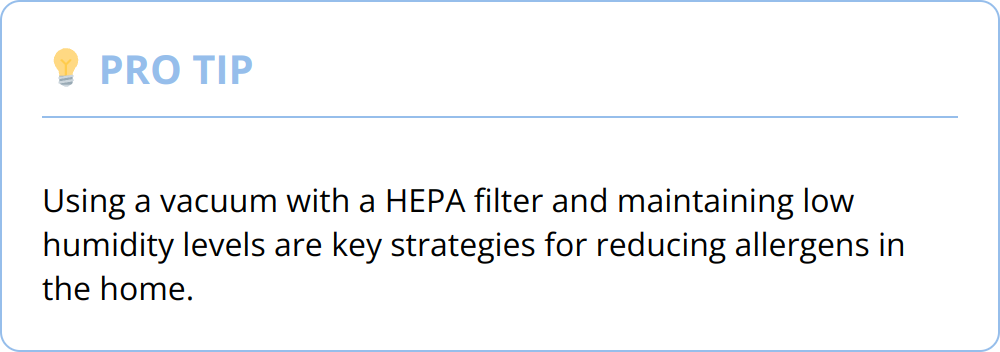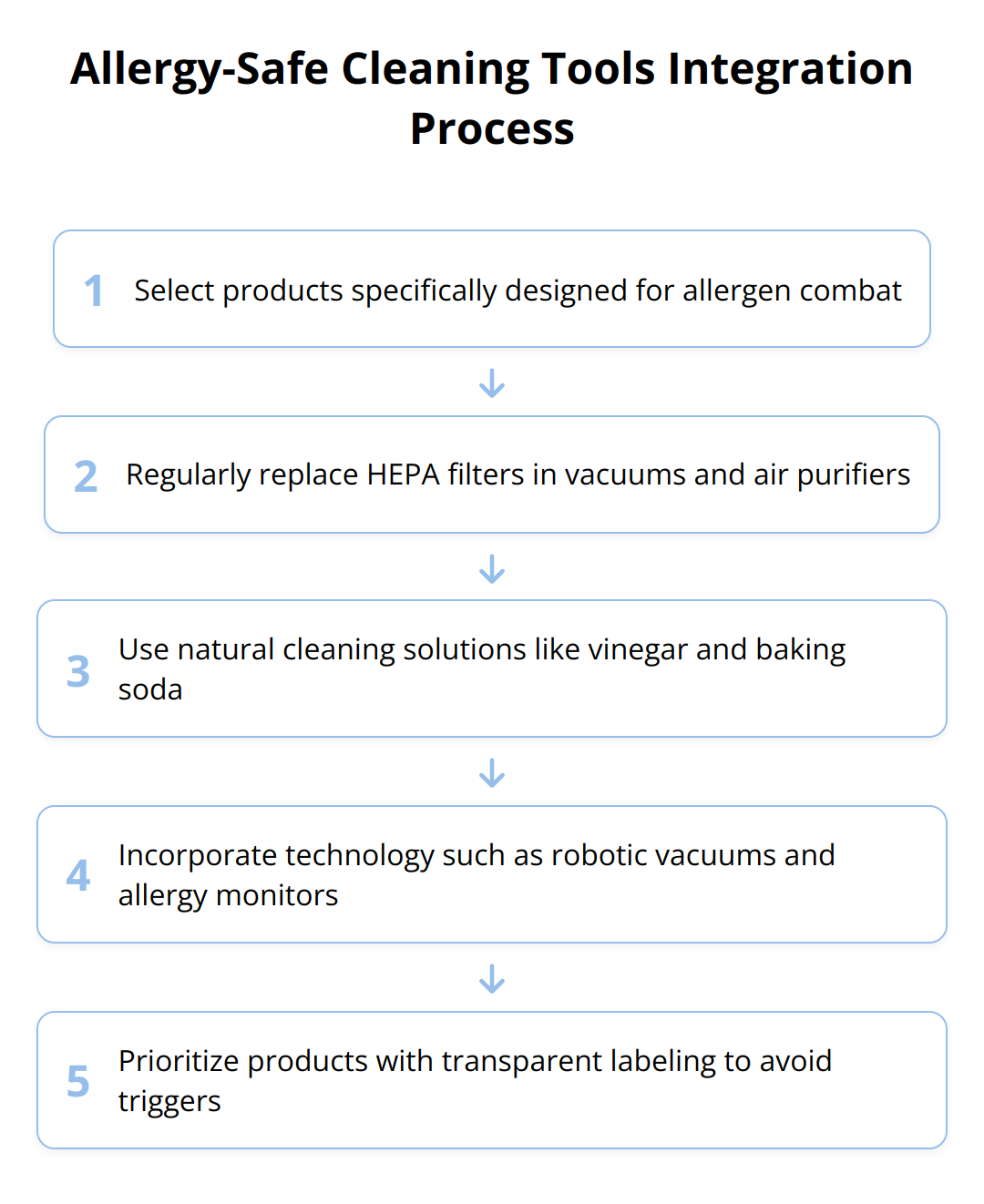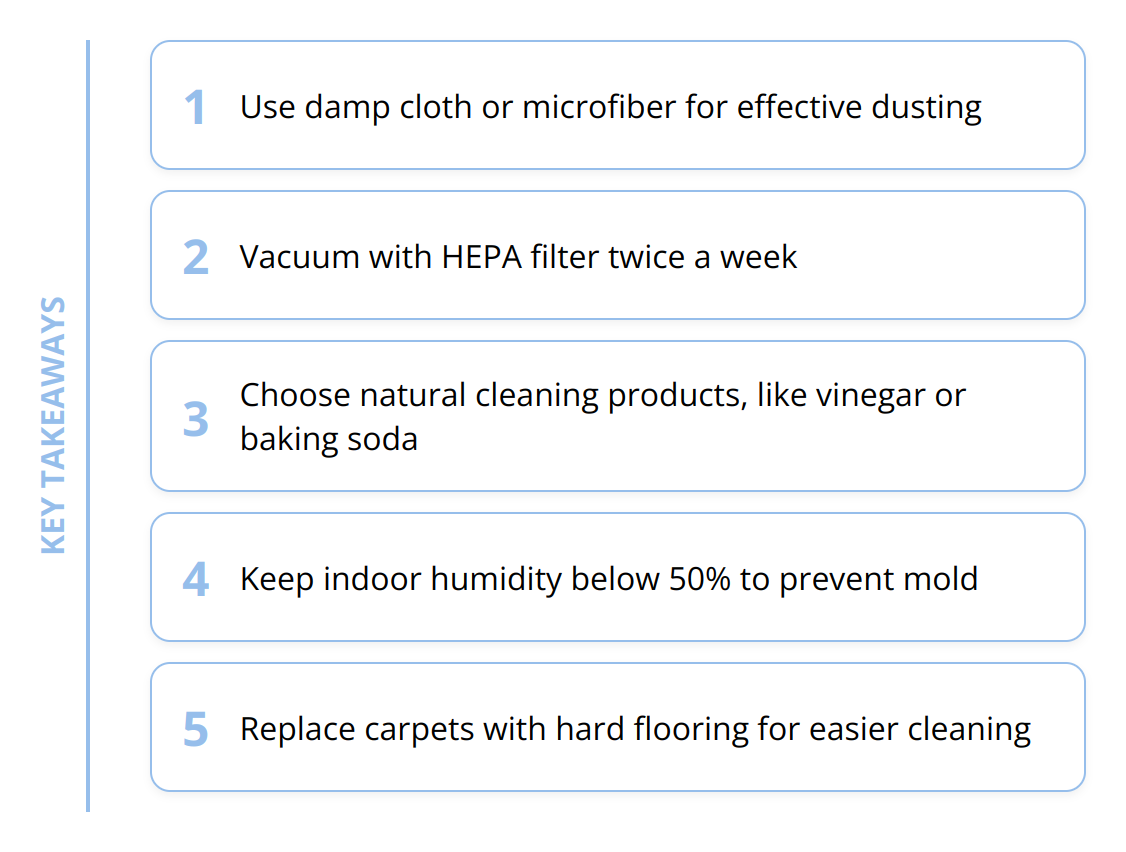Welcome to our guide on maintaining a healthy living environment free from allergens. It’s well-known that a clean home can significantly reduce allergy symptoms, offering comfort and safety to those affected.
At The A Team Cleaning Services, we’re committed to providing expertise and advice on creating allergy-safe spaces. Let’s explore effective cleaning practices that protect your health and home.
Understanding Allergy Triggers
Allergies in the home are more common than many realize, impacting the health and well-being of individuals. The culprits? Dust mites, pet dander, mold spores, and pollen – all frequent offenders hiding in plain sight. The presence of these allergens can exacerbate symptoms for those with allergies, leading to discomfort and, in severe cases, health issues. But there’s good news: adopting allergy-safe cleaning practices can significantly mitigate these risks.
The Home Allergen List
Understanding what you’re up against is step one. The most common home allergens include:
- Dust mites: Thriving in bedding, upholstered furniture, and carpeting.
- Pet Dander: Tiny flakes of skin shed by pets.
- Mold: Flourishes in damp areas like bathrooms and basements.
- Pollen: Can enter homes through open windows, doors, and on clothing.
Each allergen has its unique hiding spots and ways of affecting health. For example, dust mites and their waste products can lead to symptoms like sneezing, runny nose, and itchy eyes. Meanwhile, mold exposure can cause respiratory issues.

Health Impact of Allergens
The health implications are not to be underestimated. Allergens can trigger a range of symptoms from mild (sneezing, itchy eyes) to severe (asthma attacks, respiratory distress). For individuals with pre-existing conditions like asthma, the stakes are even higher, with allergens potentially causing dangerous flare-ups.
Why Allergy-Safe Cleaning Matters
Regular cleaning routines might not cut it when it comes to allergens. Here’s why specialized allergy-safe cleaning is non-negotiable:
- Efficiency: Certain cleaning techniques and products are more effective at removing allergens.
- Health: Reducing allergen levels in your home can significantly improve your quality of life.
- Prevention: Regular, thorough cleaning prevents the accumulation of allergens.
Incorporating strategies such as using a vacuum with a HEPA filter, favoring hard flooring over carpets, and keeping humidity levels in check can make a profound difference. Notably, hard surfaces are easier to clean and less likely to harbor allergens compared to their carpeted counterparts. Simultaneously, maintaining a dry environment will discourage mold growth.

For actionable tips on making your home more allergy-friendly, consider exploring guidance on deep cleaning and pet-friendly cleaning. These resources provide tailored advice to tackle specific allergens effectively.
Adopting allergy-safe cleaning practices is not just about cleanliness; it’s about creating a sanctuary where health and comfort coexist. By understanding the types of allergens that can infiltrate your home and taking proactive steps to minimize their presence, you’ll not only breathe easier but live better.
Allergy-Safe Cleaning Techniques
Adapting your cleaning routine to tackle allergens effectively requires a blend of smart strategies, safe cleaning products, and consistent maintenance. These techniques aren’t just about scrubbing surfaces; they’re about ensuring your home becomes a haven for those with allergies.
Effective Dusting and Vacuuming
Dusting correctly plays a pivotal role in allergen reduction. Always use a damp cloth for dusting surfaces. This method ensures allergens are captured rather than being dispersed into the air. For areas that are harder to reach, microfiber cloths are excellent as they trap dust effectively.
When it comes to vacuuming, opt for vacuums equipped with HEPA filters. These filters are adept at trapping fine particles such as pollen, pet dander, and dust mites that traditional vacuums may recirculate into the air. Vacuuming at least twice a week is recommended, paying special attention to carpets, upholstery, and areas where pets frequent.

Choosing Safe Cleaning Products
The cleaning products you choose are integral in maintaining an allergen-free space. Harsh chemicals can irritate allergies and even exacerbate symptoms. Hence, the move towards natural cleaning solutions is not only environmentally friendly but also beneficial for those with allergies.
- Vinegar is effective for cleaning windows and surfaces.
- Baking soda can be used to deodorize and clean carpets and upholstery.
For deeper cleans, consider enzyme-based cleaners, particularly for areas prone to mold growth. These cleaners break down mold at the molecular level, preventing it from returning quickly.
For more specifics on choosing and using safe cleaning products, consider exploring our guide on eco-friendly cleaning solutions.
Sustaining an Allergen-Free Environment
Regular Maintenance is key. Besides routine cleaning, consider implementing measures that reduce allergen build-up.
- Use allergen-proof mattress and pillow covers to protect against dust mites.
- Maintain indoor humidity below 50% to deter mold growth, using dehumidifiers if necessary.
- Consider replacing carpets with hardwood or tile flooring, which are easier to keep free of allergens.
- Keep windows closed during high pollen seasons to prevent outdoor allergens from coming inside.
Furthermore, paying attention to your home’s ventilation can significantly improve indoor air quality. Ensure your HVAC system is regularly serviced, and its filters are changed every three months.
Adhering to these cleaning techniques does more than just create an aesthetically pleasing home. It builds a healthier living environment, especially critical for those with allergies. By incorporating these practices into your routine, you’re not only ensuring a cleaner home but also safeguarding the health of your family. Now, with a clearer understanding of allergy-safe cleaning techniques, it’s time to put these strategies into action for a healthier, more comfortable home environment.
Tools for Allergy-Safe Cleaning
Creating an allergy-safe environment at home goes beyond regular cleaning rituals. It demands selecting the right tools and products that are specifically designed to combat allergens effectively. This is about ensuring the efforts put into cleaning yield real, health-protecting results.
HEPA Filters: A Must-Have
High-Efficiency Particulate Air (HEPA) filters are non-negotiable for anyone serious about reducing allergens in their home. These filters are engineered to capture particles as small as 0.3 microns – this includes most allergens, from dust mites to pollen. Using vacuum cleaners and air purifiers equipped with HEPA filters can significantly improve indoor air quality. Remember, these filters should be replaced regularly to maintain their efficiency. Doing so can trap over 99.97% of airborne particles, making them invaluable for allergy sufferers.
The Right Cleaning Products
The market is flooded with cleaning products claiming to be “hypoallergenic” or “allergy-friendly.” However, the best approach is often the simplest and most natural one. Solutions like vinegar and baking soda are not only safe for most people with allergies but also incredibly effective for a variety of cleaning tasks. For tackling mold, enzyme-based cleaners are a safer bet compared to bleach-based products, as they don’t release harmful fumes or residues. Always prioritize products with clear, transparent labeling about their contents. This transparency is key to avoiding products that may inadvertently trigger allergic reactions.
Innovative Cleaning Gadgets
In the battle against allergens, technology is on our side. Robotic vacuums with HEPA filters can keep floors clean without effort, and certain models are specifically designed to handle pet hair and dander efficiently. For upholstery and curtains, steam cleaners can penetrate deep into fabrics to kill dust mites and remove allergens without chemicals. Lastly, wearable technology, like allergy monitors, can track pollen levels and other environmental allergens, helping you better understand and manage your indoor air quality.

Investing in the right tools and products for allergy-safe cleaning isn’t just practical; it’s a step towards a healthier home.
For further insights on creating an allergy-safe home, explore our guides on deep cleaning benefits and choosing eco-friendly cleaning solutions.
By integrating these tools and practices into your cleaning regime, you not only ensure a cleaner home but also a space where you can breathe easier and live more comfortably, regardless of the season.
Wrapping Up
In this guide, we’ve explored various allergy-safe cleaning practices that are essential for maintaining a healthy living environment. The importance of adopting such methods cannot be overstated, especially for allergy sufferers or those aiming to foster a cleaner, safer home. From effective dusting and vacuuming with HEPA filters to choosing safe cleaning products, and maintaining regular cleaning schedules, each practice plays a pivotal role in combating home allergens.

Regular cleaning stands out as a linchpin in this array of strategies. It ensures that allergens don’t find a permanent place in your home, thus safeguarding health and improving life quality. The efficiency of allergy-safe cleaning isn’t just about removing visible dirt; it’s about creating a space where you and your loved ones can breathe easier and live more comfortably.
We strongly encourage everyone to integrate these practices into their cleaning routines. Not just for immediate results, but for the long-term benefits they bring to your health and overall well-being. It’s about making consistent efforts that contribute significantly to an allergen-free and health-friendly environment.
At The A Team Cleaning Services, we understand the nuances of maintaining an allergen-free home. Our professional cleaning services use advanced techniques and professional-grade products to address your specific needs, offering a pristine living or working environment that promotes health and safety. By choosing our hassle-free cleaning solution, you invest in a higher standard of cleanliness, saving time and eliminating the stress of dealing with allergens on your own.
Remember, creating an allergy-safe home is a continuous process that benefits greatly from professional insight and assistance. Allow us to help make your space cleaner, healthier, and more inviting. Adopting these allergy-safe cleaning practices isn’t just a step towards a cleaner home; it’s a leap towards a healthier life.
